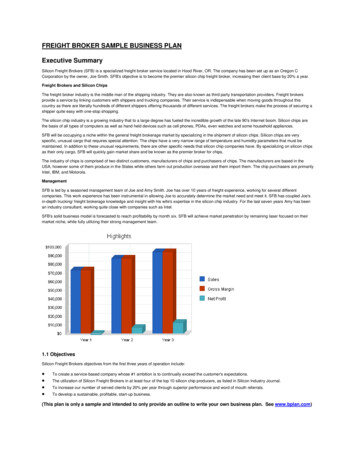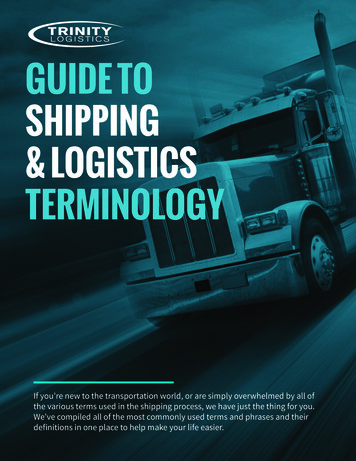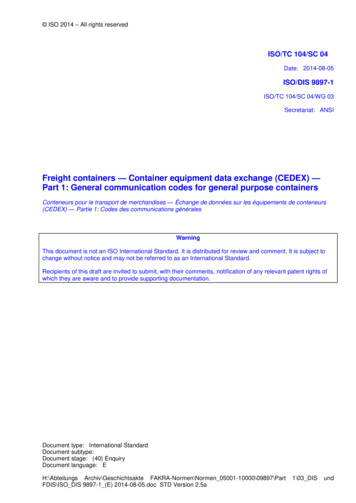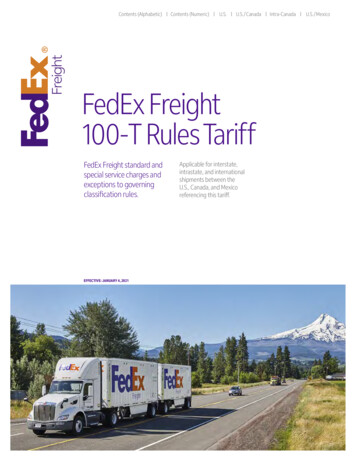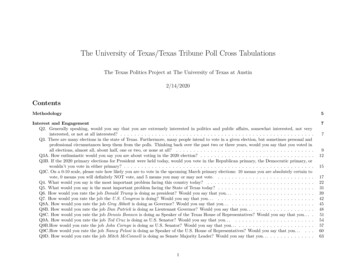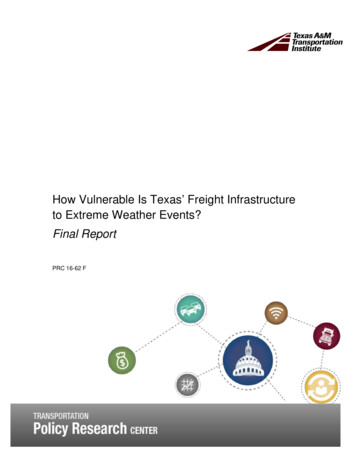
Transcription
How Vulnerable Is Texas’ Freight Infrastructureto Extreme Weather Events?Final ReportPRC 16-62 F
How Vulnerable Is Texas’ Freight Infrastructureto Extreme Weather Events?Texas A&M Transportation InstitutePRC 16-62 FMarch 2017AuthorsJohn Walewski, Ph.D.Jolanda ProzziSteven PolunskyCopies of this publication have been deposited with the Texas State Library in compliance with theState Depository Law, Texas Government Code §441.101-106.2
Table of ContentsList of Figures . 5List of Tables . 5Introduction . 6Research Goal . 6Critical Infrastructure . 6Extreme Weather . 6Causes of Weather Events .7Increasing Prevalence of Weather Events .7Most Common Hazard: Flooding .7Vulnerable Communities .7Weather Information .7Extreme Weather Impacts on Transportation . 9Key Research . 9Impacts to Traffic Volume . 10Impacts to Infrastructure . 11Extreme Weather Impacts on Freight . 12Freight Industry Recognition of Weather Patterns . 12Plans to Address Extreme Weather . 12Public- and Private-Sector Cooperation.12Suggested Approaches .13Freight Industry Response to Extreme Weather Impacts .14Freight in Texas. 15Texas’s Freight Infrastructure . 15Effects on Just-in-Time Supply Chain . 16Extreme Weather Events in Texas . 16Past Events .16Future Events .17Texas Case Studies . 18Case Study Description . 18Events Studied .18Participants .18Extreme Weather Events of Concern to Participants .18Impact of Three Case Study Extreme Weather Events . 19Memorial Day 2015 and Spring 2016 Flooding .19Hurricane Ike .22Ice Event in Dallas/Fort Worth/Panhandle Area in 2011 .23Information Needs before and during Extreme Weather Events . 24Shippers .25Trucking Companies .25Parcel Deliveries .25Marine Ports .25Formal Coordination/Communication Strategy . 26Trucking Companies .263
Parcel Deliveries .26Shippers .26Railroads .26Critical Infrastructure . 27Damage to Transportation Infrastructure .27Damage to Electric Grid .28Damage to Dams.28Government Efforts to Mitigate Extreme Weather Impacts on Transportation . 29Federal Programs. 29Federal-Aid and Federal Lands Programs .29USDOT Policy Statement .29Transportation Asset Management Plans .29Climate Resilience Pilot Program .30Programs and Practices of State DOTs . 31State-Run Programs .31NCHRP 20-83 Framework for Adaption Strategies .322015 Conference on 21st Century Mobility for Freight and Passenger Transportation .32Disaster Relief Acts . 33Stafford Act .33Texas Disaster Act of 1975 .34Budgeting for Disaster Relief . 34U.S. Government Accountability Office Report .34TxDOT Maintenance Management Manual .34FHWA Executive Order 5520 .35Upcoming NCHRP Guidelines .35Conclusion . 36References . 374
List of FiguresFigure 1. UPRR Rail Lines Impacted by Spring 2016 Flooding. . 21Figure 2. Diagram of FHWA’s Climate Change and Extreme Weather VulnerabilityAssessment Framework. . 31List of TablesTable 1. Extreme Weather Effects and Potential Responses by Freight Transportation. . 14Table 2. Extreme Weather Events of Concern. 19Table 3. Overview of FHWA 2013–2015 Climate Resilience Pilots in Texas. . 305
IntroductionThe Texas Freight Mobility Plan forecasts significant increases in freight volumes across alltransportation modes over the next three decades. An increased frequency of extreme weatherevents such as prolonged droughts and flash flooding is also expected during this time frame.Repeated severe flash flooding across the state has demonstrated the vulnerability of Texas’sfreight and transportation assets to extreme weather events.The freight community’s ability to prepare for and respond to extreme weather events is in partdependent upon the resilience of the transportation infrastructure and whether the systemmaintains functionality during and following adverse conditions. However, freight infrastructureresilience analysis, design, and planning methods are relatively immature and may limit thefreight community’s ability to effectively plan and respond to extreme weather events.Research GoalThe goal of this research was to better understand the basic issues, impacts, and current bestpractices to address the vulnerability of critical freight infrastructure to extreme weather events.Critical InfrastructureInfrastructure systems provide essential services to support the nation’s economy. Federal lawdefines critical infrastructure as systems and assets, whether physical or virtual, so vital to theUnited States that the incapacity or destruction of such systems and assets would have adebilitating impact on security, national economic security, national public health or safety, orany combination of these matters (1). Sixteen such critical infrastructure sectors are identified byExecutive Order (2); one of them is transportation.Considerations for critical infrastructure include geographic and information-relatedrelationships between manufacturers, shippers, wholesalers, retailers, and consumers;cybersystems; physical, logical, and functional connections; and situations where theserelationships have or create dependencies or interdependencies that could affect an asset’soperation (3).The U.S. Department of Homeland Security Office of Cyber and Infrastructure Analysis hasdetermined that the most likely sectors to experience infrastructure impacts from severe winterstorms are transportation and energy (4).Extreme WeatherTransportation systems have traditionally been designed to withstand historical ranges of localweather and climate. However, due to documented increases in significant weather events, thehistorical record of climate and weather is no longer a reliable predictor of future risk.6
The term extreme weather includes severe or unseasonable weather, heavy precipitation, stormsurge, flooding, drought, windstorms (including hurricanes, tornadoes, and associated stormsurges), extreme heat, and extreme cold. Extreme weather events are rarely occurring, weatherinduced events that usually cause damage, destruction, or severe economic loss (e.g., a prolongeddrought) (5).The Federal Highway Administration (FHWA) makes a clear distinction between extremeweather events and extreme events such as earthquakes or tsunamis not related to weather orclimate change.Causes of Weather EventsIt is less clear if recent extreme weather events are attributable to climate change, normalweather variability, or some combination of the two. The recently published National Academiesof Sciences report Attribution of Extreme Weather Events in the Context of Climate Changeexamined the science of attribution of specific extreme weather events to human-caused climatechange and natural variability. The report concludes that the ability to understand and explainextreme events in the context of climate change has developed very rapidly over the past decadeand is still evolving (6). The report also notes that it is now possible to estimate the influence ofclimate change on some types of specific extreme events such as heat waves, cold events,droughts, and heavy precipitation (6).Increasing Prevalence of Weather EventsA significant issue for the transportation industry is that climate change may make extremeweather events more common on a yearly basis. An Intergovernmental Panel on Climate Changestudy, released in March 2014, found that the increasing prevalence of severe weather will havenegative effects on infrastructure, agriculture, and the overall well-being of humans (7).Most Common Hazard: FloodingFlooding is the most common environmental hazard because about 10 percent of U.S. land isconsidered in a flood plain (an area prone to flooding), and every state has at some time in therecent past experienced floods or flash floods. From 2005 to 2014, total flood insurance claimsaveraged more than 3.5 billion. Death and fatalities from these floods are in the thousands.Ninety percent of Presidential Disaster Declarations involve some sort of flooding (8), andresearch has shown that the risk of floods is increasing because of rising sea levels (9).Vulnerable CommunitiesAn additional concern is that the population in the United States is moving to and becomingdenser in vulnerable areas such as coastal communities and hurricane-prone areas (10).Weather InformationAn assessment of available weather information for surface transportation, conducted in 2002(11) and updated in 2006 (12) and 2007 (13), found that a considerable amount of information7
regarding current weather conditions and forecasts is available to the consumer, and that bothsafety and economic benefits can result from efforts to further improve weather information.8
Extreme Weather Impacts on TransportationKey ResearchExtensive research exists on the impacts of extreme weather on transportation—infrastructure,personnel, and practices. Key reports include: Literature Review: Climate Change Vulnerability Assessment, Risk Assessment, andAdaptation Approaches reviews transportation vulnerability and risk assessments up to2009. The author notes, “Incorporation of climate change impacts into transportationdecisions is still a relatively new concept” (14). “The Potential Impacts of Climate Change on Transportation” describes the findings of a2002 workshop held by the U.S. Department of Transportation (USDOT), U.S.Department of Energy, and Environmental Protection Agency (15). A number ofgovernmental and nongovernmental entities attended the workshop. The workshop noteda significant need for research about the relationships between climate change andtransportation. Impacts of Climate Change and Variability on Transportation Systems andInfrastructure: Gulf Coast Study (16) examined the Gulf Coast from Houston/Galveston,Texas, to Mobile, Alabama. This area was selected “due to its dense population andcomplex network of transportation infrastructure, as well as its critical economic role inthe import and export of oil, gas, and other goods” (17). Phase 1 was completed in 2008,and phase 2, focusing on the Mobile area, was completed in 2015. Key concerns are sealevel rise and increase in temperatures, which will speed up deterioration of highways,bridges, and rail lines; exacerbate flash flooding; and affect the integrity of soils andfoundations. The study resulted in development of tools for assessing vulnerability and awebinar series on building a climate-resilient transportation system. These tools areonline at https://www.fhwa.dot.gov/environment/climate change/adaptation/ongoing and current research/gulf coast study/. The results of this studyhave informed later FHWA efforts to guide transportation entities, such as ClimateChange and Extreme Weather Vulnerability Assessment Framework (2012) (18) andPlanning for Systems Management and Operations as Part of Climate ChangeAdaptation (2013) (19). Impacts of Extreme Weather on Transportation: National Symposium Summary (20)provides the findings of a May 2013 symposium sponsored by the American Associationof State Highway and Transportation Officials (AASHTO). The symposium addresseddefining extreme weather, projecting the future, determining extreme weather costs, anddeveloping mitigation strategies through infrastructure design, operation, andmaintenance.9
Response to Extreme Weather Impacts on Transportation Systems (21) covers a variety ofextreme weather events and lessons learned from those events, devoting an entire chapterto drought and wildfires in Texas. The report highlights issues of concern totransportation infrastructure providers, such as the off-system role of a state departmentof transportation (DOT) in disaster, communications, interagency coordination, andknowledge management. The report also discusses the need for strategies for detours andoutreach to the freight community. NCHRP Report 750: Strategic Issues Facing Transportation, Volume 2: Climate Change,Extreme Weather Events, and the Highway System: Practitioner’s Guide and ResearchReport (22) notes the evolving understanding of the relationship between climate changeand transportation infrastructure, reiterates findings about climate change, and lays out aneight-step framework for planning extreme weather adaptation. Regarding Texas, thestudy cites the National Resources Defense Council’s statistics that in 2012 Texas had “atotal of 144 broken heat records, 8 broken snow records, 115 broken precipitationrecords, and 34 large wildfires” (22). Surface Transportation System Resilience to Climate Change and Extreme WeatherEvents (23) summarizes a 2015 international conference on the subject and notes urgencyfor action even in the absence of government requirements regarding preparation for ormitigation of extreme weather events. The summary discusses climate change in thecontexts of inland waterways, airports, and ports, and case studies of the MassachusettsPort Authority and Alaska’s Dalton Highway. Other studies suggest innovations such as including crowd-sourced information in postevent roadway assessment (24), using quantitative methods to enhance resilience inintermodal logistics networks (25), routing multi-commodity intermodal freight duringdisruptions using models (26), and using ground-based LiDAR and drone-basedphotography to assess infrastructure damage and inspect bridges (27).Impacts to Traffic VolumeTransportation modes are sensitive to any weather—for example, a light mist can makehighways slick and more conducive to vehicle crashes—but are more sensitive to weatherextremes (28). Extreme weather can affect traffic volume during the event and have long-lastingimpacts on infrastructure afterward. In one case study, unusually heavy rainfall reduced vehiclespeeds by one-fourth, cut traffic volume in half, and flooded or damaged many bridges,underpasses, road surfaces, and vehicles (29).Increases in delay and travel time created by weather events can have a direct financial impact onusers in an area. For example, freight operators lose about 3.4 billion (about 32 million hours)stuck in weather-related traffic delays in metropolitan areas. A one-day highway shutdown cancost a metropolitan area up to 76 million in lost time, wages, and productivity (30).10
Impacts to InfrastructureUnderstanding and classifying the impacts of weather events on transportation resources havealso been pursued. The New York Academy of Sciences developed three categories to identifypotential impacts: “Temperature-related infrastructure and material stresses such as greater freeze-thawcycles, buckling of road and rail beds due to intense heat etc.“Temperature-related user stresses such [as] requiring more use and employment ofventilation, air conditioning etc.“Water-related infrastructure stresses such as flooding, saltwater intrusion, moisturedamage from humidity, bank erosion due to heavy rainfalls etc.” (31).11
Extreme Weather Impacts on FreightFreight Industry Recognition of Weather PatternsThe trucking industry has recognized increased difficulties from extreme weather and the need toaddress the resulting issues. In 2015, Phil Sneed of Tandem Logistics wrote (32):Trucking and logistics companies, in addition to drivers, also have to account formore disruption, including the changing environment. Truckers have long beenaccustomed to driving through all types of weather, rain or shine. However, recentcountry-wide weather patterns have contributed to more transformationalchanges.Sneed cites the polar vortex of 2013–2014, the resulting shutdown of multiple interstatehighways, and their effects on up to 50,000 trucks and 200 trains as key indicators.Go by Truck News wrote, “Increased flooding in the Midwest has caused so much sedimentdegrading around bridge abutments that the bridges are likely to give way under the force of anadded stress, whether from overloading, wind or earthquake” (33).A study of the Boston metropolitan area found that climate change may result in “a doubling ofdelays and lost trips” but that this outcome would “probably not” be sufficient to justify largeexpenditures to adapt infrastructure (34).It is also possible that climate change results in milder winter conditions, which could decreasetime lost to shipments due to severe winter weather and improve safety for some modes (28).Plans to Address Extreme WeatherIdentifying specific industry plans to address extreme weather is difficult. Those identifiedduring this investigation include general and practical guidance. For example, XTL, a Canadiantransportation and logistics company, advises shippers that best practices are to pre-plan, monitorweather conditions, and work with the carriers (35).Public- and Private-Sector CooperationProgrammatic efforts to address the critical infrastructure aspect of transportation areincreasingly risk informed but vary widely from jurisdiction to jurisdiction (36). Efforts areenhanced through the use of public-private partnerships, which are particularly successful atacquiring and disseminating best practices (36). Once created, public-private partnerships arechallenging to sustain because funding is reduced and personnel face other demands (36).The freight network in particular can involve a combination of public- and private-sectorownership structures and thus can have a complex web of laws and regulations that apply (37). Anumber of useful public- and private-sector planning guides and resources exist, such as theNational Oceanic and Atmospheric Administration Sea Level Rise and Coastal Flooding Viewer(https://coast.noaa.gov/slr/), but their use may require a certain level of expertise (37). A private12
company’s ability to invest in mitigation or resilience measures may depend on its businesscontinuity planning process, level of vulnerability assessment (single asset to entire system),financial resources, and perception of risks and consequences (37).Suggested ApproachesThe following approaches offer ways to deal with extreme weather: One approach to resilience is to have redundancy in routes—multiple routes that canaccommodate the same shipment (38). In terms of railroads, options have decreased overtime because the miles of rail nationally have decreased from 254,000 in 1914 to 138,000in 2014 (38). For hazardous materials, railroad shippers are required to follow a numberof federal mandates, including the use of a 27-factor algorithm assessing relative risk andthe avoidance of densely populated areas (38). To ensure minimum disruption and a quick return to normal operations, intermodalcoordination and cooperation are required. A study of Hurricane Sandy cited lack ofintermodal coordination. The study found that efforts put into restoring port operationswere not met with sufficient road or rail efforts to provide adequate service (39). Based on lessons learned in Hurricane Irene, the Research Foundation of the NationalAssociation of Development Organizations recommends involving regionaltransportation planning entities to improve coordination among local and state agenciesand formalizing these entities’ roles in transportation disaster response (40). The New York City Panel on Climate Change identified several possible steps to take inthe operations and management area: improve pumping, increase backup emergencyequipment, and improve storm information and forecasting; for soft infrastructure, makeareas around stations porous to promote drainage; and for hard infrastructure, raiseseawalls and barriers, and elevate runways and low-lying tracks and roadways (41). Researchers have suggested that actions taken to increase resilience, such as storing extravehicles to replace those disabled, system redundancies, and relocation of facilities tohigh ground, may increase economic efficiency as well (31). Current research has developed methods of identifying dollar value benefits of wintermaintenance operations in terms of safety, mobility, and fuel savings (42). Future effortsmay help provide a cost-benefit basis for expenditures on resilience. Current research holds hope for improving resilience. Research in areas such as soiltemperature prediction (43), extreme weather risk indicators for transportation systems(44), urban traffic flow in inclement weather (45), anti-icing applications (46), acombination of historical and scenario-based data for weather projections (47), andrailroad ballast erosion (48) continues to improve our ability to provide mobility inextreme weather conditions.13
Freight Industry Response to Extreme Weather ImpactsThe freight industry has pursued a variety of responses to extreme weather events. Table 1provides a summary of extreme weather effects and the potential responses by the freightindustry.Table 1. Extreme Weather Effects and Potential Responses by Freight Transportation.Extreme Weather EffectIncreased frequency, duration, and intensity ofdroughts; increased coastal and inland floodingIncreased frequency, duration, and intensity ofdroughts; increased coastal and inland floodingIntense single event severely damaging ordestroying assetLonger duration and/or shifting of springtimefreeze/thaw periodIncrease in magnitude and duration of severeheat wavesIncrease in magnitude and duration of severeheat wavesIncrease in magnitude and duration of severeheat wavesIncrease in magnitude and duration of severeheat wave14Freight Transportation ResponseRestricted access to ports and shippingchannels for inland waterwaysMode shift to trucking due to reducedreliability of other modesRe-routing or delay in shipping freightMandatory freight diversion to morerobust alternative routesMandatory freight diversion to morerobust alternative routes or modesDynamic or seasonal restrictions for trucksor rail during times of high heat, reducingeither acceptable speed or weightPolicy and regulation changes to restricttruck size and weig
Change and Extreme Weather Vulnerability Assessment Framework (2012) (18) and Planning for Systems Management and Operations as Part of Climate Change Adaptation (2013) (19). Impacts of Extreme Weather on Transportation: National Symposium Summary (20) provides the findings of a
